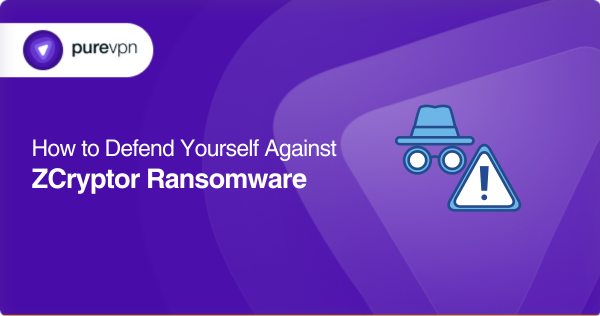Table of Contents
Threats to your digital assets are constantly evolving in the world of cybersecurity. One such threat that has wreaked havoc in recent years is ransomware, malicious software that locks you out of your data until a ransom is paid.

In this article, we’ll focus on one type of ransomware – ZCryptor Ransomware – and provide practical tips on safeguarding your digital assets from this threat. With the increasing frequency and severity of cyber attacks, it’s more important than ever to be informed and prepared.
So, let’s dive into the world of ZCryptor Ransomware and learn how to defend ourselves against it.
Unpacking ZCryptor Ransomware: The basics
In this section of the article, we’ll examine what ZCryptor Ransomware is, how it evolved, how it works, and some of its key features.
What is ZCryptor Ransomware?
ZCryptor is a sophisticated type of malware that encrypts files on a computer system and demands a ransom payment for the decryption key. It was first discovered in May 2016, and since then, it has evolved into one of the most destructive and aggressive ransomware variants.
The evolution of this software
The earliest versions of ZCryptor Ransomware were delivered via spam emails and drive-by downloads. These versions of the ransomware were relatively unsophisticated. They used a hard-coded encryption key, making them easier to decrypt.
However, as security researchers became aware of the ransomware, the developers behind it improved its capabilities. It has since gone through several evolutions. What started as simple ransomware with limited capabilities developed into a hybrid malware. It now combines features of both ransomware and worms.
The latest version of ZCryptor Ransomware can infect not only your files but also the Master Boot Record [MBR] of the infected system, making it more difficult to remove. In addition to email attachments and drive-by downloads, they now also come in the form of fake software updates.
How does it work?
ZCryptor Ransomware typically enters a computer system through various entry points, such as phishing emails or malicious downloads. Once it has infected a computer, it will begin to encrypt files on the system, making them inaccessible to the user.
The ransomware will then display a ransom note, demanding payment in Bitcoin in exchange for the decryption key. Furthermore, it uses a combination of AES-256 and RSA-2048 encryption to encrypt files on the infected system.
The ransomware will encrypt all files with certain extensions such as .doc, .ppt, .xls, and .pdf. Once the encryption process is complete, the ransomware will append the extension .zcrypt to the encrypted files.
The key features of ZCryptor Ransomware
Zycryptor is known for its aggressive and destructive features. Its key features include a malware dropper that allows it to spread to other computers and an auto-propagation feature that enables it to infect removable drives and network shares.
Another key feature is its payment portal which demands a ransom payment in Bitcoin. The ransomware can also infect the Master Boot Record [MBR] of the infected system, making it more challenging to remove.
Identifying the ZCryptor Ransomware threat
ZCryptor ransomware is a serious threat that can cause severe damage to your digital assets. In this section, we’ll discuss some common signs, entry points, types of targeted files, and how you can determine if you’re at risk.
Signs of the ZCryptor Ransomware infection
The signs of this threat can be subtle, but if you know what to look for, you can detect it early on. Some of the signs that your computer may be infected with ZCryptor Ransomware include the following:
- Files with the .zycrypt extension: When the ransomware encrypts files on your computer, it appends the .zcrypt extension to the filenames.
- Ransom note: ZCryptor Ransomware displays a ransom note on the screen, demanding payment in Bitcoin in exchange for the decryption key.
- Slow performance: It can slow down your computer’s performance, making it more difficult to use.
The common entry points for this ransomware
This malicious software can enter your computer system through various entry points. Here are some of the most common entry points you must know:
- Phishing emails: ZCryptor can be delivered via phishing emails that contain malicious attachments.
- Malicious downloads: You may download it from malicious websites, or it may be disguised as legitimate software updates.
- Drive-by downloads: The malicious software can be delivered through infected websites that automatically download and execute the ransomware on your computer.
Types of files targeted
The ZCryptor Ransomware targets a wide range of file types, including:
- Documents such as .doc, .docx, .xls, and .ppt.
- Image files such as .jpg, .png, .bmp.
- Video files such as .mp4, .avi, .mov.
- Audio files such as .mp3, .wav, .aac.
The fury of the ZCryptor Ransomware: Understanding its impact
The following are some of the consequences you may face as a victim of the ZCryptor Ransomware:
- Data loss and destruction: This ransomware can encrypt and lock your files, making them inaccessible and potentially causing permanent data loss if you don’t pay the ransom or have backups.
- Financial loss: Paying the ransom demanded can be costly, and there is no guarantee that the attacker will provide the decryption key even after payment.
- Reputational damage: A ransomware attack can damage an individual’s or organization’s reputation. This is especially true when sensitive information is compromised or lost.
- Economic impact: There are numerous financial and economic impacts of such attacks, including the cost of ransom payments, lost productivity, legal costs, and the need for increased security measures to prevent future attacks.
Protecting yourself against the ZCryptor Ransomware
The following are a few methods to safeguard yourself against ZCryptor Ransomware:
- Evaluate your system’s security: Review your current security measures and assess whether they are strong enough to protect against a ransomware attack. This includes evaluating your firewall, antivirus software, and other security measures in place.
- Monitor for suspicious activity: Keep an eye out for any unusual or suspicious activity on your computer, such as changes to your files or programs or unexpected pop-up messages.
- Check for vulnerabilities: Use vulnerability scanning tools to identify any weaknesses or vulnerabilities in your system that could be exploited.
- Stay informed: Stay updated on this ransomware’s latest news and developments, including new variants and attack methods. This will help you stay informed about potential risks and take appropriate action to protect your system.
- Keep your software up to date: Ensure you install the latest software updates and patches to protect yourself against known vulnerabilities that can be exploited.
- Use antivirus software: Install and use antivirus software to detect and prevent such infections.
- Use a VPN: VPNs [virtual private networks], such as PureVPN, encrypt your online activity and protect you from data breaches and ransomware attacks.
- Be cautious: You should be careful when opening emails from unknown senders and downloading files from the internet.
- Backup your files: Regularly backing up your important files to an external hard drive or cloud storage service can protect you against data loss in case of a ransomware attack.
- Train employees: Educate your employees on the dangers of ransomware and how to avoid it.
- Use strong passwords and two-factor authentication: Utilize complex passwords and two-factor/multi-factor authentication to reduce the risk of unauthorized access to your systems and data.
- Use firewalls: Implement firewalls to restrict unauthorized access to your systems and data.
- Enable automatic backups: Schedule regular automatic backups of your data to an external hard drive or cloud storage service.
- Utilize anti-malware and anti-ransomware software: Install reputable anti-malware and anti-ransomware software and keep them up to date.
What to do if your computer is infected
The following are a few initial steps you can take if your computer has been infected with the ZCryptor Ransomware:
- Isolate the infected system: Disconnect the infected device from the network to prevent the further spread of the ransomware.
- Identify the ransomware: Determine the type of ransomware that has infected the system. In the case of ZCryptor Ransomware, the files will be remanded with a .zcrypt extension.
- Contact law enforcement: Report the attack to the authorities.
- Use secure backups: Use secure backups to recover data after the attack.
- Consult with data recovery experts: In cases where backups are not available, you can consult with data recovery experts, who may be able to recover the encrypted data.
- Learn from the attack: Evaluate the response to the attack and implement improved security measures to prevent future attacks.
Please note that paying the ransom does not guarantee that the data will be recovered, and it may encourage attackers to continue their activities. Therefore, it’s best not to pay the ransom. Furthermore, you should avoid deleting the encrypted files in case they can be recovered later.
You should also never attempt to remove the ransomware as it may delete important information required for data recovery.
Concluding remarks
Ransomware is a serious threat to individuals and organizations alike. The best defense against this type of attack is prevented through cybersecurity measures and ongoing vigilance. Following the tips outlined in this guide, you can protect your digital assets and minimize the risks of falling victim to such attacks.
As a leading provider of VPN and cybersecurity services, PureVPN can help you stay protected against ransomware attacks and other online threats. Its state-of-the-art security features and easy-to-use software give you the peace of mind you deserve.
Try PureVPN today and experience the ultimate in online privacy and protection.
Frequently Asked Questions
ZCryptor Ransomware is a type of ransomware that encrypts the files on a victim’s computer and demands a ransom payment in exchange for the decryption key. It can spread through various methods, including phishing emails, infected websites, and software vulnerabilities.
You can prevent a ZCryptor Ransomware infection by keeping your software up to date, using antivirus software, being cautious with emails and downloads, regularly backing up your important files, and using a VPN, such as PureVPN.
It is generally not recommended to pay the ransom if you’re infected with the ZCryptor Ransomware. There’s no guarantee that you will receive the decryption key, and paying the ransom only encourages cybercriminals to continue their activities.
Yes, while primarily designed to target Windows computers, ZCryptor can be modified to infect Mac computers as well.
PureVPN can help you protect yourself from ZCryptor Ransomware by providing a secure VPN connection, encrypting your internet traffic, and helping prevent cyberattacks.



